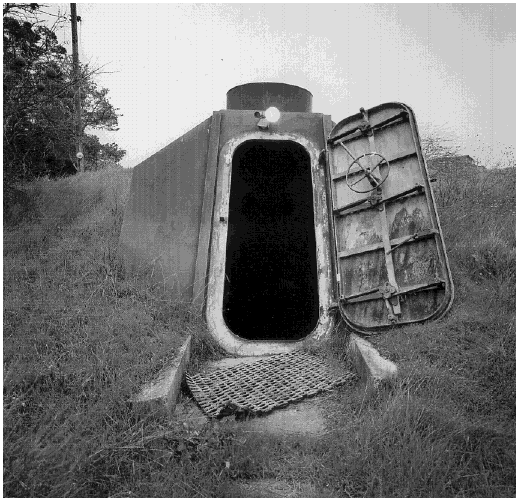End of the World
Richard Ross
(Princeton Architectural Press)

Some of them weren't even built in this century, so they weren't necessarily fall-out shelters, unless you call Christian invasion an undesirable fall-out. The Muslims of Acca in what is now Israel built one in 1100 A.D. just to protect themselves from the depredations of those bloody Crusades sent down by the religious fundamentalists of the day. Even further back, in 2,000 B. C. the Hittites of Cappodocia carved a shelter in the hills. The stone was such that it could dissipate the smoke of their cooking fires to help them avoid discovery.
The most lurid of them all is to be found hidden behind the wallpaper of the Greenbriar Hotel in White Sulphur Springs, West Virginia. It was built in the early 1960s and was set aside so the president and his staff and all members of the U. S. Congress could fly in during nuclear attack on the Capitol. It could hold up to 1,800 people. Mr. Ross claims it was a big secret until an exposé that appeared several years ago in the Washington Post, but this is nonsense. Most of us knew about it, knew that in case our government blew it, they --- those who blew it --- would survive, even though the rest of us would be little heaps of dust.
 When I heard of this, I wrote a letter to my congressman. I asked if he would let me know when they were going to evacuate for Greenbriar because my girlfriend and I would like to come along. I assured him that we wouldn't take up much space, wouldn't eat too much nor in any way inconvenience our roommates.
When I heard of this, I wrote a letter to my congressman. I asked if he would let me know when they were going to evacuate for Greenbriar because my girlfriend and I would like to come along. I assured him that we wouldn't take up much space, wouldn't eat too much nor in any way inconvenience our roommates.
I said we would bring our own sleeping bags and sleep on the floor if it were necessary and that if they permitted, I would bring my guitar. I said that it should not be cause for concern, for it was an acoustic guitar. "I never sing or play loudly," I reported. "Perhaps I would be allowed to sing a few patriotic songs from time to time ... to keep everybody's spirits up."
The Secret Nile
Victorian Exploration in
Equatorial Africa
1857 - 1900
Guy Yeoman
(Chaucer Press
20 Bloomsbury
London)
- what was the provenance of so much water, feeding a river that flowed constantly out of the desert.
Those who made the journey were a strange bunch. Samuel Baker had his wife make designer exploration outfits looking like oriental pajamas. John Hanning Speke punished those who disagreed with him by what the English eponymously call "speaks" --- ignoring their very presence. James Grant put up with months of traveling with Speke (or no speaks). David Livingstone, was "presumed upon" (in the words of the author) by Henry Morton Stanley. And, finally, there was Richard Burton, famed pornographer and, also, (according to the author) "a sadist ... a drinker and a rake." In other words, just the kind of adventurer that you and I would give an arm or a leg to travel with into deepest Tanganyika.
The Nile runs for over 4,000 miles, and --- next to the Los Angeles sewage system --- is the longest river in the world. The tale of the ultimate discovery is told here in workaday prose. The final take on the discoverer of the source: no one person was capable of finding it all, there were just too many sources.
The photographs presented here are lucious, the binding and stock are delicious, good enough to eat, although the end result, as is usual in cases like this, is dismal. "The waters have now become dangerously polluted, spreading environmental degradation throughout the catchment... Lake Victoria is dying." Some malign spirits introduced the Nile perch. That has resulted in the "collapse of the lake's almost infinitely varied fish population." Some other fools brought in the common water hyacinth, which "forms massive impenetrable floating mats that suffocate the fish breeding grounds and block the movement of boats and canoes."
Cleopatra was known to Antony as "My serpent of old Nile," and serpents put her finely and finally to sleep at the end of Act 5. And, wrote Edward Lear, "We live on the Nile,"
- The Nile we love.
By night we sleep on the cliffs above.
By day we fish, and at eve we stand
On long bare islets of yellow sand.

